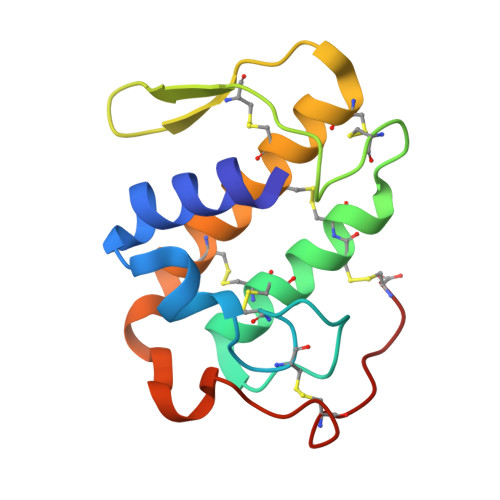Crystal structure of a phospholipase A(2) homolog complexed with p-bromophenacyl bromide reveals important structural changes associated with the inhibition of myotoxic activity.
Marchi-Salvador, D.P., Fernandes, C.A., Silveira, L.B., Soares, A.M., Fontes, M.R.(2009) Biochim Biophys Acta 1794: 1583-1590
- PubMed: 19616648
- DOI: https://doi.org/10.1016/j.bbapap.2009.07.005
- Primary Citation of Related Structures:
2OK9 - PubMed Abstract:
For the first time, the structure of a catalytic inactive phospholipase A(2) homolog (Lys49-PLA(2)s) complexed with p-bromophenacyl bromide (BPB) has been solved by X-ray crystallography. Lys49-PLA(2)s are among the main components of Viperidae snake venoms, causing myonecrosis and other actions despite their catalytic inactivity. BPB, a classic inhibitor of catalytic-active PLA(2)s, has been used since the 1970s because it binds specifically the His48 residue of the catalytic site. Curiously, when Lys49-PLA(2) is chemically modified by BPB, it causes a partial inhibition of the myotoxic function which is associated with the C-terminus and not with the catalytic site. The structure of PrTX-I complexed to BPB revealed unambiguously that the inhibitor binds covalently to His48, causing a distortion of the Ca(2)(+)-binding loop region and C-terminus rearrangement in one of its monomers. The comparison between the apo and BPB-complexed PrTX-I structures showed an increased symmetry between the two monomers with the formation of an interchain hydrogen bond between Tyr119 residues. PrTX-I undergoes tertiary and quaternary structural changes when complexed to BPB which could be related to reduction of myotoxicity and other toxic activities. We also proposed a novel myotoxic inhibition hypothesis integrating "myotoxic" and "active" sites for bothropic Lys49-PLA(2)s.
- Departamento de Física e Biofísica, Instituto de Biociências, UNESP, Distrito de Rubião Jr., Caixa Postal 510, 18618-000, Botucatu-SP, Brazil.
Organizational Affiliation:


















